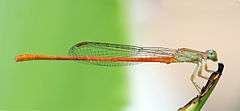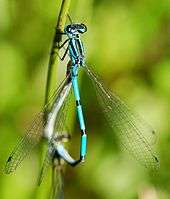Coenagrionidae
| Coenagrionidae | |
|---|---|
 | |
| Male Ceriagrion glabrum | |
| Scientific classification | |
| Kingdom: | Animalia |
| Phylum: | Arthropoda |
| Class: | Insecta |
| Order: | Odonata |
| Suborder: | Zygoptera |
| Superfamily: | Coenagrionoidea |
| Family: | Coenagrionidae |
| Genera | |
|
More than 90 genera are accepted; see text. | |
The insect family Coenagrionidae is placed in the order Odonata and the suborder Zygoptera. The Zygoptera are the damselflies, which although less known than the dragonflies, are no less common. More than 1,100 species are in this family, making it the largest damselfly family. The family Coenagrionidae has six subfamilies: Agriocnemidinae, Argiinae, Coenagrioninae, Ischnurinae, Leptobasinae, and Pseudagrioninae.
This family is referred to as the narrow-winged damselflies or the pond damselflies.[1] The Coenagrionidae enjoy a worldwide distribution, and are among the most common of damselfly families. This family has the smallest of damselfly species. More than 90 genera of the family Coenagrionidae are currently accepted.[2]
Etymology
The name may be derived from Greek coen meaning shared or common and agrio meaning fields or wild.
Characteristics
.jpg)
- Usually have a black pattern
- Ground color may be green, blue, yellow, orange, or purple
- Narrow, stalked, usually colorless and clear wings
- Two antenodal cross veins
- Vein M3 arising nearer to nodus than arculus
Adults are seen around various habitats including ponds and wetlands. The females lay their eggs among living or dead submerged vegetation, and in some species, even crawl about underwater depositing their eggs. The nymphs are usually found in debris or among living or dead submerged plant material.[3]
Genera
The following is a complete list of genera:
- Acanthagrion
- Acanthallagma
- Aceratobasis
- Aciagrion
- Aeolagrion
- Africallagma
- Agriocnemis
- Amphiagrion
- Amphiallagma
- Amphicnemis
- Amorphostigma
- Andinagrion
- Angelagrion
- Anisagrion
- Antiagrion
- Apanisagrion
- Argia
- Argiagrion
- Argiocnemis
- Archboldargia
- Archibasis

- Austroagrion
- Austroallagma
- Austrocnemis
- Azuragion
- Bedfordia
- Boninagrion
- Bromeliagrion
- Caliagrion
- Calvertagrion
- Cercion
-_Male_W_IMG_3835.jpg)
- Ceriagrion
- Chromagrion
- Coenagriocnemis

- Coenagrion
- Cyanallagma
- Denticulobasis
- Diceratobasis
- Dolonagrion
- Enacantha
- Enallagma
- Erythromma
- Helveciagrion
- Hesperagrion
- Himalagrion
- Homeoura
- Hylaeargia
- Hylaeonympha
- Inpabasis
- Ischnura
- Leptagrion
- Leptobasis
- Leucobasis
- Megalagrion
- Melanesobasis
- Mesamphiagrion
- Mesoleptobasis
- Metaleptobasis
- Millotagrion
- Minagrion
- Moroagrion
- Mortonagrion
- Nehalennia
- Neoerythromma
- Nesobasis
- Onychargia
- Oreagrion
- Oreiallagma
- Oxyagrion
- Oxyallagma
- Pacificagrion
- Palaiargia
- Papuagrion
- Papuargia
- Paracercion
- Pericnemis
- Phoenicagrion
- Pinheyagrion
- Plagulibasis
- Proischnura
- Protallagma
_W_IMG_0876.jpg)
- Pseudagrion
- Pyrrhosoma
- Rhodischnura
- Schistolobos
- Skiallagma
- Stenagrion
- Teinobasis
- Telagrion
- Telebasis
- Tepuibasis
- Thermagrion
- Tigriagrion
- Tuberculobasis
- Tukanobasis
- Vanuatubasis
- Xanthagrion
- Xanthocnemis
- Xiphiagrion
- Zoniagrion
References
- ↑ Borror, D.J.; White, R.E. (1970). A Field Guide to Insects. Boston: Houghton Mifflin Company. ISBN 0-395-91171-0.
- ↑ Integrated Taxonomic Information System (2007). Coenagrionidae, retrieved November 4, 2007.
- ↑ John L. Capinera (2008). Encyclopedia of Entomology. Springer Science & Business Media. pp. 1244–1245. ISBN 978-1-4020-6242-1.
External links
See also
| Wikimedia Commons has media related to Coenagrionidae. |
| Wikispecies has information related to: Coenagrionidae |